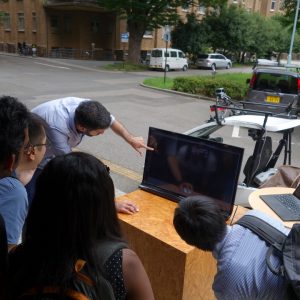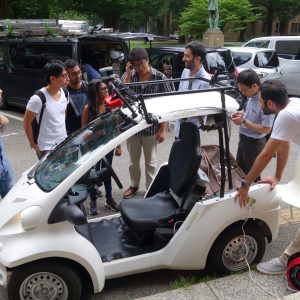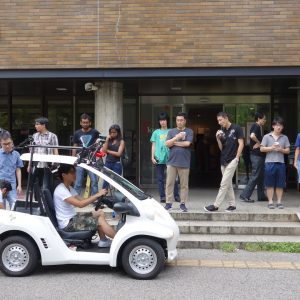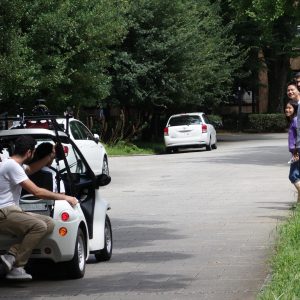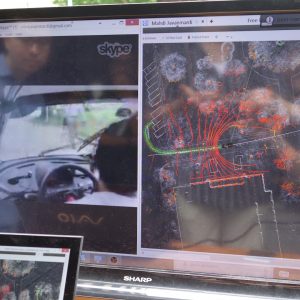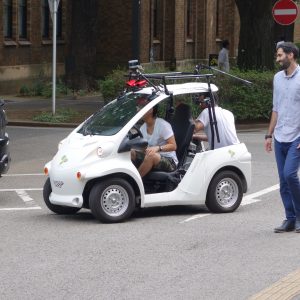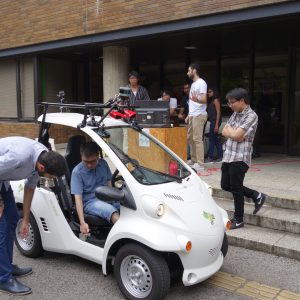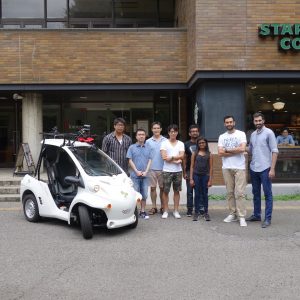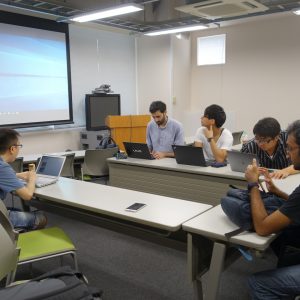
Safe and Effective Autonomous Vehicle Experiments
The “self-driving car” is a promising future technology that will bring significant impacts and changes to our society. An autonomous and self-driving mobility platform can help many GCL students to boost their social projects. However, implementing a safe and effective autonomous driving experiment requires knowledge and experience. This workshop aimed to introduce the MUSCAT platform to the students who are interested in self-driving cars and their social benefits, and strengthening their skills in designing a safe and effective autonomous driving experiment. The workshop attendees were also asked to help the MUSCAT members to draft a safety manual by joining a brainstorm at the end of the workshop.
By attending this workshop, attendees could become familiar with the key components of the driverless cars, observe the step-by-step procedure of an autonomous driving experiment, and experience self-driving cars for themselves. During the self-driving experience, they had to pay attention to the requirements of safe experiment design consisting of experiment planning, required checklists, safety considerations, dealing with emergency situations, and how to report after the experiment. Moreover, this workshop gave the students an opportunity to think about how MUSCAT can assist their research and social projects, and provide us with feedback to define our future development priorities.
The specific outcome of this workshop was a manual titled “GCL MUSCAT Safety Manual” which is currently being used by everyone who uses the MUSCAT platform. This workshop was an excellent opening for the MUSCAT global design workshop series, which will be followed by our next workshop titled GCL-MUSCAT Workshop #2 “Workshop on Autonomous Driving.”
Background of project
The MUSCAT project is an interdisciplinary project in GCL supervised by Dr. Tsukada and aims to provide autonomous driving technology to the GCL students who believe that their social innovation project might be boosted by this technology. We can look at the self-driving cars from two different perspectives―that of an autonomous driving expert and that of a user from a different domain. The first perspective looks at this technology as a complex system that is made of multiple components, and these components are processing and transferring a vast amount of information. The second perspective considers the self-driving car as a black box system that can provide them with smart and autonomous transportation. To reach a state in which the MUSCAT project can boost the GCL students’social projects, we must gather people from these two perspectives to actively collaborate and exchange their ideas. To do so, we planned the GCL- MUSCAT workshop series, which began with the workshop “Safe and Effective Autonomous Vehicle Experiments,”and was followed by the second workshop,“Workshop on Autonomous Driving.”
The core idea of this workshop was to introduce the MUSCAT platform to the GCL students and draft a safety manual for our experiments inside the campus. In fact, a solid safety manual is a must if we want to perform autonomous driving experiments in the campus environment.
About this Workshop
This workshop began at the GCL-lab with short self-introductions by the lecturer and attendees, and continued with an hour-long lecture on“Self-driving cars: Localization and Mapping.”In the lecture, the two main components of the self-driving cars― localization and mapping―were described in detail.
After that, we changed locations from the GCL-lab to beside the Starbucks café on the Hongo campus. There, the facilitators demonstrated autonomous driving on a predefined route to familiarize the attendees with the real experiment environment.
After having lunch, every student sat behind the wheel at least once to experience how the system works, and how it reacts to other road users such as pedestrians or other cars during the experiment. Since each person perceives safety from their own perspective, we put everyone into the real experiment environment to make them observe and experience the possible challenges.
After everyone experienced the autonomous driving, we moved back to the room and asked the students to share their own observations during the workshop to draft the safety manual. The ideas from the multiple perspectives helped us to make a solid safety manual that can be used in the future.
プログラム
| 15min | Self-introduction | |
|---|---|---|
| 60min | Lecture on "Self-driving cars: localization and mapping" | |
| 15min | Workshop instruction | |
| 30min | Self-driving demonstration by instructors | |
| (Lunch time) | ||
| 150min | Self-driving experiment by students | |
| (Coffee break) | ||
| 15min | Group discussion instruction | |
| 90min | Group discussion (brain storming for the safety manual design) | |
| 30min | Reflection | |
| 30min | Wrap up |
Outcome
The specific achievement of this workshop was a manual titled“GCL MUSCAT Safety Manual.”This manual provides the basic checklists required for performing an experiment using the MUSCAT platform. Currently, a rule is set that whoever wants to join an autonomous driving experiment using MUSCAT must read and complete the checklist in this manual and follow its instructions line by line. Also, it is mandated that the responsible person should write down a quick report and take a photo of the checklist and send it to Dr. Tsukada, after each experiment. The safety manual consists of four checklists: pre-experiment, during the experiment, emergency, and post- experiment. The safety manual can be accessed from this link: https://goo.gl/ dRdLpx.
Reflection
The main goal of this workshop was to introduce the MUSCAT platform to the GCL students and to involve them in the process of designing a solid safety manual. We believe that the workshop was successful, but there is still a long way to go to ensure that many GCL students can employ the full potential of the MUSCAT platform for their social innovation projects.
The safety manual designed in this workshop obligates the students to report every accident or potentially dangerous situation they face during the experiment. This obligation guarantees that the safety manual can frequently be updated based on the new experiences we face each time.
Besides updating this manual, we should grow the network of both professionals and other users of MUSCAT. To be able to achieve the goal of attracting people from different majors and backgrounds, we should organize similar workshops from time to time. The future workshops should focus on two aspects: One aspect is to train new members and make them able to fully operate the MUSCAT platform. And the other aspect is to attract more students from different majors and motivate them to use this technology in society.
| アイテム | Autonomous driving vehicle, Autonomous driving software, PowerPoint, Whiteboard, Laptop, LCD, Wireless internet |
|
|---|---|---|
| 開催日時 | 2017.8.23 (Wed) 10:00 - 18:30 |
|
| 場所 | Hongo campus, the University of Tokyo |
|
| 参加者・人数 | 6 persons |
|
| 講師/ファシリテーター | Mahdi Javanmardi |
原稿執筆:Mahdi Javanmardi




